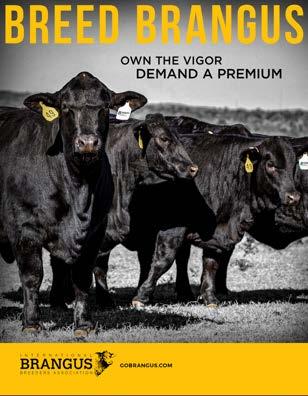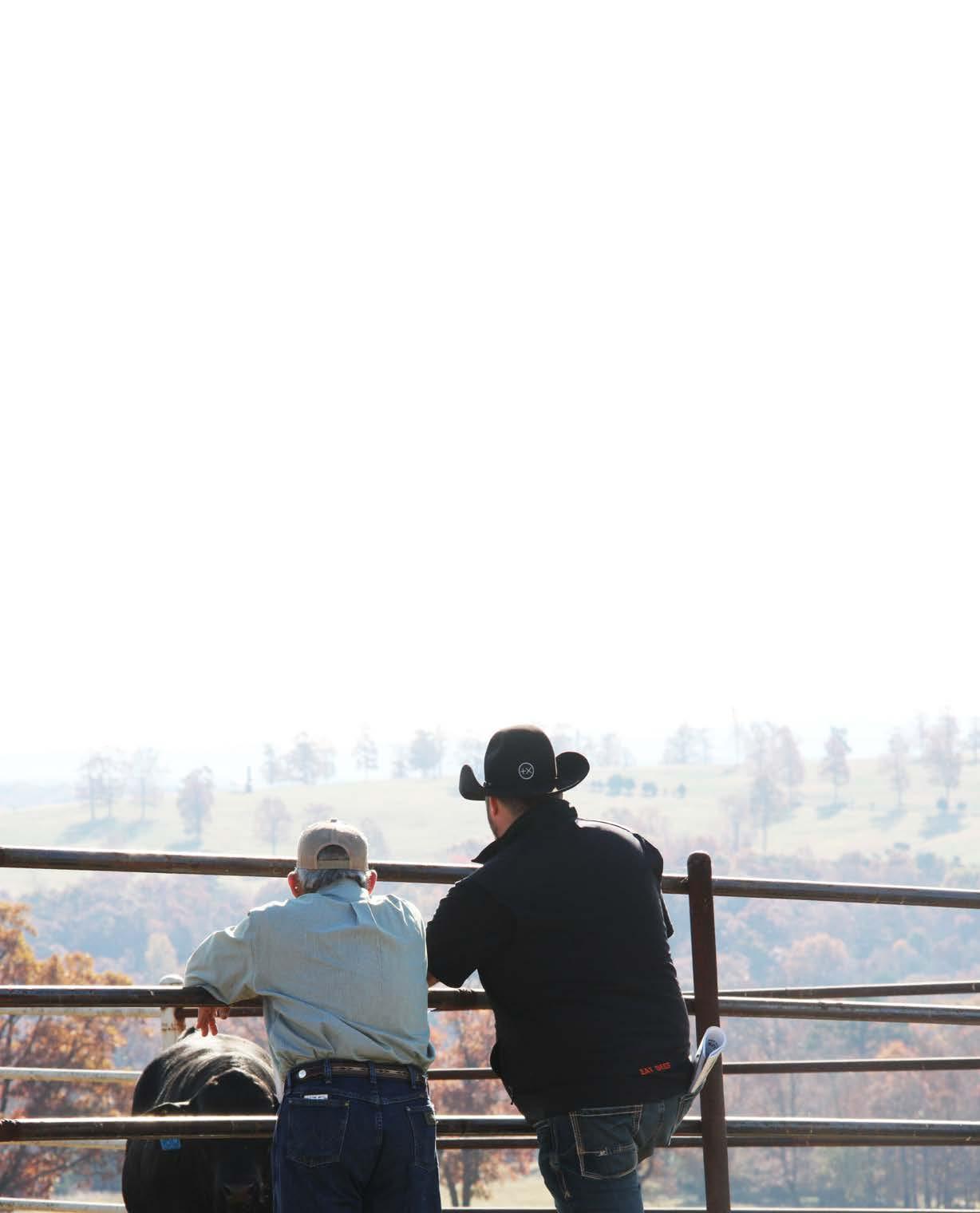
11 minute read
THE KEYS TO HIGHLY SUCCESSFUL BULL SALES
Highly Successful THE KEYS TO BULL SALES
by Bob Hough
Many people feel there is a great mystery on why one outfit’s bull sale is successful, while another fails. However, the components of a successful sale are actually straight forward, and can be boiled down to leadership, breeding, and marketing. The key to success is how well each of these are implemented and if they are prioritized in the correct order. Those who master these components will dominate the market.
BE A LEADER
When people are choosing a bull supplier—whether they are a commercial or seedstock customer—they are first and foremost choosing the people with whom they want to do business. Buyers are attracted to seedstock suppliers with a vision on how to build a profitable cow herd. Ones that also have a reputation for providing their customers with the pertinent data needed to make an informed decision and then stand behind their bulls once sold. Next, buyers are drawn to the reputation of the person’s bulls themselves and the logic of the breeding program from which they came. Ultimately, buyers are attracted to thought leaders not followers and it’s a common expression that people like to be led. So, one of the first questions for someone who seeks to be a highly successful seedstock operation is: Are you a thought leader or just following the crowd? Success comes to both the buyer and seller when the seedstock operation has a program that is recognizable and consistent year after year.
Seedstock managers also need to be well educated and up to speed on the latest science of cattle breeding. They can choose not to use one of the latest tools, but they need to have a logical, fact-based reason. The sad but true reality of the cattle business is the average commercial cow-calf producer that is making a living on their cattle is far more advanced in their knowledge of selection technology than your average seedstock breeder. Commercial cow-calf producers have businesses that deal in large gross sales but narrow margins. These narrow margins mean their livelihoods can depend on taking advantage of all the technology available. This includes the science that helps custom fit genetically a commercial herd to a ranch’s unique matrix of environment, management, feed resources, and market. A seedstock supplier’s ability to design genetics that best fit this matrix of their customers are well on their way to success.
BREED BETTER CATTLE
Most breeders focus on how much they can sell their cattle for, but their first priority should be to breed better cattle and then see how much they can market them for. We are in a data driven world and if a trait is not quantifiable and repeatable, you cannot make genetic progress on that trait. Some of these traits will have genetic predictions and some will not, but they all can be measured in some form. Sometimes that is categorical. For instance, the International Brangus Breeders Association does not have a disposition EPD, but it is a heritable trait which can be defined in a limited number of categories that will give their customers a good idea what to expect when they get them home. In terms of looks, cull any unsound animals and any that are too ugly to sell. Ugly is something each producer has to define, but after that let the bull buyers sort them out.
Today’s genetic predictions are more precise and reliable than a person could ever have imagined 20 years ago. However, the statistics and methodology behind them has become ever more complicated and difficult to understand. This difficulty to understand their underpinnings leads some producers to reject modern genetic predictions out of hand. This is to the long-term detriment of their operation. Today’s genetic predictions give the best estimate of what the actual genetics of an animal are, while other forms of selection contain both genetics, as well as the noise of the environment. The bottom line is for the traits that have objective genetic predictions, they should be used to design a producers breeding program regarding the traits they describe and then keep and cull based on production and performance.
MARKETING
Many people who want to have successful sales think the place to start is marketing, but marketing is only truly effective once you have a clear vision for breeding cattle and the outstanding bulls that reflect that vision. You don’t start out seeing how much you can sell them for. Rather, the first place to start is by breeding better cattle based on a program that will draw people to come buy them with a well-coordinated marketing plan. Another key is you don’t set out to breed that one home run bull that will sell for an eye-popping amount to a fellow seedstock buyer. Design your
breeding program, so the bulls will sell for an amount that will be profitable for you but still reasonable enough that your commercial buyer can make money. If you do this, some of those “eye-popping” bulls that will be desired by a seedstock producer will naturally rise up.
When developing your marketing plan, realize that your customers will have a wide range of ages, which results in them getting their information from a variety of sources. Therefore, a well-designed marketing campaign needs to range from traditional print advertising to social media. Like the genetic predictions where it’s hard to understand how they are calculated, it is also difficult for any producer to have expertise in all the needed media. Therefore, it’s important to know when you need to bring in outside expertise and what you can handle internally. The key is that your marketing materials have a recognizable look that customers associate with your ranch and, convey in a few words, the essence of your philosophy. The ultimate goal is to tell in a very concise way how your cattle are bred to excel in a manner that will drive potential customers to more information and ultimately to spend money. One constant in commercial bull marketing is that breed magazines have special editions that go to an expanded list of past commercial bull buyers. For Brangus, the Frontline Beef Producer represents the most ideal target commercial audience.
KNOW WHEN TO BECOME A COOPERATOR
As can be seen in the first three segments—leadership, quality, and marketing—there is a lot involved in having an elite sale where cattle command high prices. Most all seedstock breeders are top cattle managers that are expert at collecting large amounts of high-quality data. However, far fewer have a clear philosophy and vision of how to make their customers more profitable and sustainable through the use of their designed genetics. The last really big job is the marketing, which is where most producers have the least amount of experience and inclination.
If any or most of the above paragraph applies to you, success may best come by being a cooperator with a larger operation that excels in leadership, genetics, and marketing. By being part of a larger system, increased critical mass is achieved by all involved, which stretches marketing dollars and ability to attract larger operations to a sale.
Generally, the cooperator system works by each ranch choosing which bulls to use from a list provided by the larger ranch that will be doing the marketing. This provides sire groups of significant size to interest buyers in half-sibs. The cooperator is then responsible for maintaining valid contemporary groups and arranging to have healthy, fully preconditioned calves trucked to a central location. There they will be developed together with the other cooperators and the parent ranch’s bulls. The bulls are generally sold under one iron, and the parent ranch is responsible for telling the story of the program and marketing the bulls. If the truth be told, most seedstock breeders would be best served by feeding into a system like this rather than marketing bulls on their own.
Being a leader in determining what is needed for profitable genetics, breeding great cattle and then implementing a great marketing program are the keys to success. Those who decide their goal is to sell a high price bull only through marketing will rarely be successful. The key is to market a large quantity of bulls profitably, letting that high price bull naturally rise to the top. Not all are capable of implementing this successful formula; in that case, their best course forward is to align themselves with those that are doing it and becoming a cooperator.

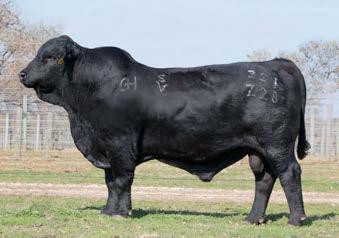
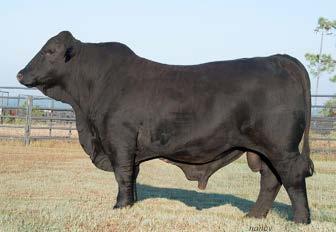



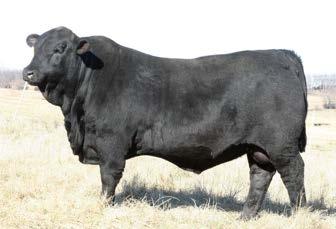


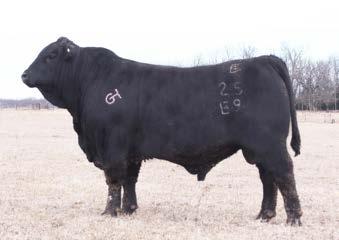


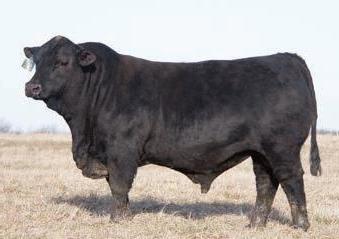



GENEPLUS

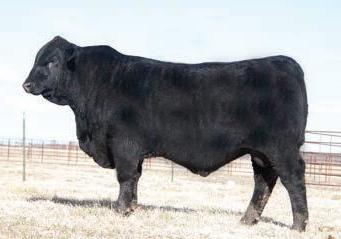
GENEPLUS
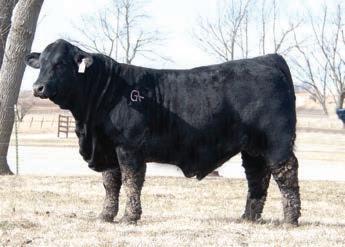

PROMOTING THE BRANGUS BREED:
THROUGH ACTIVE ENCOURAGEMENT
by Joe Fuller, IBBA Promotions Committee chairman


Promotion…a familiar word that if you look up various definitions means: taking a product or business and creating awareness, building demand to buy a product, providing positive reinforcement to loyal customers, increasing use of a product and even providing information on a product/ business. Another definition of promotion that applies to our Brangus breed is an activity that supports or provides active encouragement for the furtherance of a cause, venture, or aim. We do have a cause, our love for this great breed of cattle. We all have ventures that we have invested time, money, and hard work. We have an aim, which is the course been charted by the IBBA Long Range Planning Committee and the IBBA Board of Directors.
The IBBA Promotion Committee is charged with setting the course for promoting the Brangus breed and increasing market share for Brangus cattle through active encouragement. I will compliment this committee for being super engaged and active in getting to this point and ready for layering on the progress we have made to this point. The 2021 committee is comprised of Trey Cuevas, Wade Fisher, Sara Green, Shiloh Hall, Lisa Neal, Andrew Scamardo and Kurt Trammell along with the staff support of Lori Edwards and Darrell Wilkes. I am so very appreciative for this committee and all their work!
How do you promote a breed of cattle? There are as many opinions on that as there are opinions on bloodlines of cattle. The first step is creating an image for the breed that creates a stir or wakes up folks that have not been paying attention to our great breed of cattle. Those images are shared on a variety of platforms such as trade publications, social media, internal websites, search engines, web banners, direct mail, trade shows, and industry events.
To create the content, the committee worked hard to determine an advertising agency to send a fresh message and image to the beef industry. The agency that IBBA has chosen to work with is Cross Timbers Marketing of Hudson Oaks, Texas and they are involved in all facets of marketing for companies and organizations focusing on agriculture and outdoors. They created the ads on this page and the verbiage in the ads came directly from the work of the IBBA Long Range Planning Committee and the information the committee gathered from large feeding organizations, packers, and leading ranches.
This “look” will be expanded across all IBBA activities so we have a brand that is recognized when promoting the Brangus breed in cattle publications, trade shows, the IBBA website, social media postings, and even our Brangus Sire Directory.
The IBBA Promotion Committee was also charged, along with staff, to make the Frontline Beef Producer a more financially viable publication for the breed. We worked on who should get this breed promoting publication. It was decided that Brangus bull buyers of the past five years would. The committee also added the Seedstock Directory to make the publication more available and affordable for all breeders wanting to promote to the commercial industry. We achieved our goals and now the Frontline is on positive financial track. Promoting the Brangus breed, both black and red, Ultrablacks, and Ultrareds will be an ever-evolving process with additional cattle images and themes that stay true to our goal of improving the Brangus market. Active engagement is what this committee is all about and we are committed to growing our breed.
